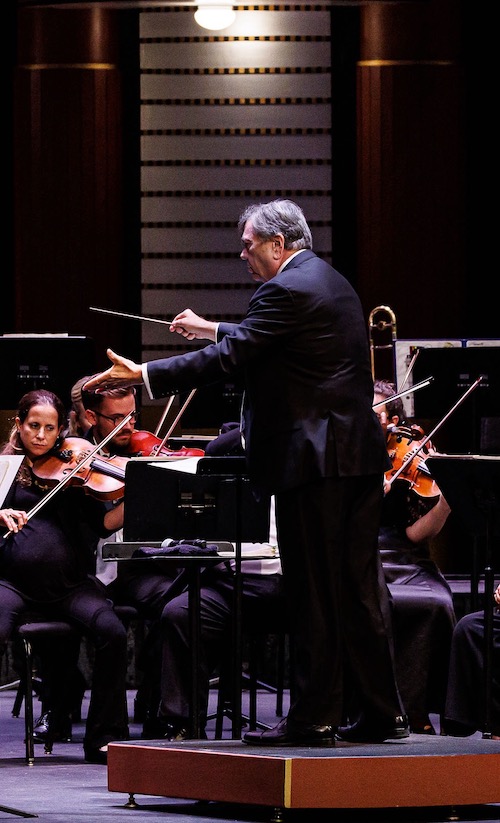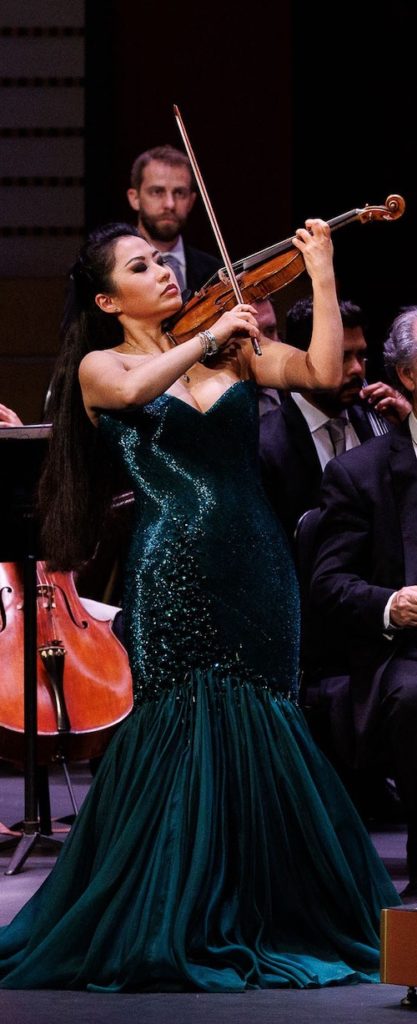Schwarz launches Palm Beach Symphony season with an American classic and belated Brahms premiere

Gerard Schwarz conducted the Palm Beach Symphony in music of Brahms, Bruch and David Diamond Sunday at the Kravis Center. Photo: IndieHouse Films
When Gerard Schwarz took the helm of the Palm Beach Symphony, listeners who knew his work expected to hear more American music.
He provided a good dose of that Sunday in the orchestra’s season- opening concert, with a performance of David Diamond’s Rounds for String Orchestra. Schwarz, an American music specialist, was a close friend of Diamond’s, recording many of his works and appearing on NPR for an interview on the occasion of the composer’s death in 2005 at the age of 89.
The Diamond work, composed in 1944 in a modest effort to cheer a war-weary nation, is energetic, accessible music that would turn out to be the composer’s most popular composition. The Palm Beach orchestra’s strings have rarely sounded better, playing with accuracy, incisiveness and lively athleticism, as melodies cascaded one upon the next. In the slow middle section, a preponderance of lower strings gave the melody extra warmth and humanity, leading to music that ended high in tones of wintry delicacy. The high-speed music returned in the finale, with the strings continuing to generate maximum energy from this populist music.
After this refreshing burst of American optimism, the audience was treated to one of the most overplayed works of the core Austro-German repertory, Max Bruch’s Violin Concerto No. 1. Bruch, who composed two other worthy violin concertos and a shelf of other works, feared he would be remembered only for the wildly popular concerto he composed at the age of 28, and he appears to have been right.
The work’s over-exposure, particularly in South Florida, doesn’t mean it’s not a great piece, and it shows off the violin with a stream of dramatic episodes and memorable melodies. The soloist was Sarah Chang, who had played the Bruch at the age of 5 on a 1/16th size violin for her Juilliard audition (she got in).

Sarah Chang performed Bruch’s Violin Concerto No. 1 with the Palm Beach Symphony on Sunday. Photo: IndieHouse Films
But Chang’s performance Sunday was highly uneven. Her playing of the improvisatory opening was powerful, building it to a point of maximum tension with a rich, dark tone. And in the arpeggios that bring the movement to an end, she played with fortissimo brilliance, angling the scroll of her violin high as she stood up to the surging tones of the entire orchestra.
But she hurried over much of the movement; the fast notes became an indistinct blur, her intonation was uncertain and the drama of the music left by the wayside. In the central Adagio, her tone on the lower string was rich, full and intimate, as she played the melodies that account for much of the concerto’s popularity. But in contrasting sections she still rushed, and her tone in the upper register turned wobbly. The last movement came off as more workmanlike than brilliant, without the assertive virtuosity needed to really carry it off.
It’s a measure of the youth of the Palm Beach Symphony, founded in 1974 but really coming into its own in the past few years, that the program listed Brahms’ Symphony No. 2 as a “Palm Beach Symphony premiere.”
Schwarz led a straightforward account of the symphony, which found the orchestra in its prime. The brass section had a particularly good day, purring and growling with refined, understated power in the opening movements and opening up with joyful abandon in the symphony’s exuberant ending. Horns, to which Brahms often assigned his most evocative music, played with accuracy and assertive force. The lurking darkness of the sunny first movement, with its rumbling timpani and moments of minor-key melancholy, appeared particularly prominent, with Schwarz generating a particularly ominous pianissimo before the sunshine bursts out in the full orchestra.
Like most master conductors, Schwarz was able to keep the natural volume advantage of the brass from overpowering the other sections. But violins felt underpowered at times, particularly in the turbulent middle section of the Adagio. That was an exception, however, in a performance that featured, full-bodied, accurate string playing.
The last movement can generate some scrappy string playing, with all the rapid sawing away called for in the score. But the musicians tackled the music without losing the crisp, incisive textures they brought to the rest of the concert. The final statement of the main theme came off as the surging, affirmative statement it was meant to be, filling the hall with music as joyful as any Brahms ever produced.
The concert opened with the audience rising for the traditional season curtain-raiser of The Star-Spangled Banner,” led by Mary Bryant McCourt, Maestro for a Day Gala Auction Winner.
Gerard Schwarz conducts the Palm Beach Symphony 8 p.m. December 1 at the Kravis Center. The program includes Sibelius’s Night Ride and Sunrise, Saint-Saëns’ Symphony No. 3, and Beethoven’s Piano Concerto No. 5 with soloist Garrick Ohlsson. palmbeachsymphony.org
Posted in Performances
Leave a Comment
Mon Nov 7, 2022
at 3:32 pm
No Comments